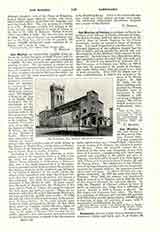

Sannazaro, Jacopo (Latin, ACTIUS SINCERUS SANNAZARIUS), Italian and Latin poet, b. at Naples, July 28, 1458; d. at Rome, in August, 1530. He belonged to a family of Spanish origin, in the service of Charles III of Durazzo, holding the fief of Rocca di Mondragone from the end of the fourteenth century. He received the name by which he was known because he was born on the feast of St. Nazarius. Having lost his father at an early age, he lived in Nocera dpi Pagani with his mother; returning later to Naples, he studied with Pontanus and was a member of the academy which assembled about this scholar. In this group he received the name of Sincerus by which he is often mentioned in the letters of the times. He was closely allied with the princes of Aragon at Naples and followed Federico into the exile to which he was driven by Louis XII, King of France (1521). Relying on the generosity of the French king, Federico established himself at Tours, and Sannazaro remained with him until his death (September 9, 1504). During this time Sannazaro discovered a MS. containing the hitherto unknown works of Latin poets, the fragment of the “Halieutica” ascribed to Ovid by Pliny the Elder, the “Cynegetica” of Grattius Faliscus, Nemesianus, and Rutilius Namatianus. MS. 227 of Vienna is actually the portion of this MS. which contained the “Halieutica” and Grattius. MS. 3261 of Vienna is only a sixteenth-century copy of Nemesianus and Rutilius. On returning to his own country Sannazaro left it no more. In his old age he had the sorrow of seeing his villa of Tore di Mergoglino destroyed by the imperial forces. He had just rebuilt it when he died.
In his youth Sannazaro wrote a work in mingled verse and prose entitled “Arcadia”, in which he described the pastoral life according to the traditions of the ancients. This work had great success; it was translated and imitated, and in the sixteenth century had about sixty editions; the first was at Venice, May 12, 1502. The “Arcadia” gave rise to the pastoral style of writing much cultivated in Italy and elsewhere. A scholarly edition was issued by Scherillo (Turin, 1888). Sannazaro’s other Italian poems were sonnets and canzoni. All were collected by Gallipoli (Padua, 1723). A correspondent of Paulus Manutius mentions another work called “Gliomero”, now lost. A work entitled “Farsa” affords an idea of it. It consisted of detached scenes of a popular character, written in the Neapolitan dialect, and intended to amuse the king’s Court.
Sannazaro’s poetical reputation was formerly founded on his Latin works: the “Ecologiae piscatoriae”, bucolic verses concerning fishers, elegies and epigrams containing interesting details concerning the life of the poet and contemporaries, his mistresses, Carmosina, Bonifacia, and Cassandra, and which are the best evidences of his sentiments; “Salices”, account of metamorphosis; and especially the “De partu Virginis”, a poem in three cantos which cost him twenty years of labor and won him the name of the Christian Virgil. These works show that he was a diligent imitator of Ovid and Virgil. The Christian poem is a mixture of the antique and the modern, of mythology and Biblical reminiscences. Digressions often far from happy are inserted as ornaments, for instance in connection with the ass of the manger Sannazaro reviews all the legends in which the ass has played a part. He also abuses allegorical personifications. The poem, praised by Leo X before it was known, is dedicated to Clement VII, who covered it with praise. Sannazaro’s Latin works were published by Volpi (Padua, 1719) and Janus Bronkhusius (1728).
PAUL LEJAY

